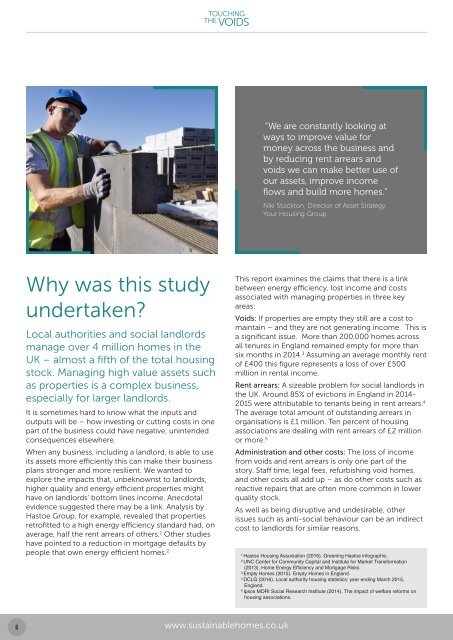voids
w7Fk302h3jh
w7Fk302h3jh
You also want an ePaper? Increase the reach of your titles
YUMPU automatically turns print PDFs into web optimized ePapers that Google loves.
Touching<br />
The <strong>voids</strong><br />
“We are constantly looking at<br />
ways to improve value for<br />
money across the business and<br />
by reducing rent arrears and<br />
<strong>voids</strong> we can make better use of<br />
our assets, improve income<br />
flows and build more homes.”<br />
Niki Stockton, Director of Asset Strategy,<br />
Your Housing Group<br />
Why was this study<br />
undertaken?<br />
Local authorities and social landlords<br />
manage over 4 million homes in the<br />
uK – almost a fifth of the total housing<br />
stock. Managing high value assets such<br />
as properties is a complex business,<br />
especially for larger landlords.<br />
it is sometimes hard to know what the inputs and<br />
outputs will be – how investing or cutting costs in one<br />
part of the business could have negative, unintended<br />
consequences elsewhere.<br />
When any business, including a landlord, is able to use<br />
its assets more efficiently this can make their business<br />
plans stronger and more resilient. We wanted to<br />
explore the impacts that, unbeknownst to landlords,<br />
higher quality and energy efficient properties might<br />
have on landlords' bottom lines income. Anecdotal<br />
evidence suggested there may be a link. Analysis by<br />
hastoe group, for example, revealed that properties<br />
retrofitted to a high energy efficiency standard had, on<br />
average, half the rent arrears of others. 1 other studies<br />
have pointed to a reduction in mortgage defaults by<br />
people that own energy efficient homes. 2<br />
This report examines the claims that there is a link<br />
between energy efficiency, lost income and costs<br />
associated with managing properties in three key<br />
areas:<br />
Voids: if properties are empty they still are a cost to<br />
maintain – and they are not generating income. This is<br />
a significant issue. More than 200,000 homes across<br />
all tenures in england remained empty for more than<br />
six months in 2014. 3 Assuming an average monthly rent<br />
of £400 this figure represents a loss of over £500<br />
million in rental income.<br />
Rent arrears: A sizeable problem for social landlords in<br />
the uK. Around 85% of evictions in england in 2014-<br />
2015 were attributable to tenants being in rent arrears. 4<br />
The average total amount of outstanding arrears in<br />
organisations is £1 million. Ten percent of housing<br />
associations are dealing with rent arrears of £2 million<br />
or more. 5<br />
Administration and other costs: The loss of income<br />
from <strong>voids</strong> and rent arrears is only one part of the<br />
story. staff time, legal fees, refurbishing void homes,<br />
and other costs all add up – as do other costs such as<br />
reactive repairs that are often more common in lower<br />
quality stock.<br />
As well as being disruptive and undesirable, other<br />
issues such as anti-social behaviour can be an indirect<br />
cost to landlords for similar reasons.<br />
1<br />
Hastoe Housing Association (2016). Greening Hastoe infographic.<br />
2<br />
UNC Center for Community Capital and Institute for Market Transformation<br />
(2013). Home Energy Efficiency and Mortgage Risks.<br />
3<br />
Empty Homes (2015). Empty Homes in England.<br />
4<br />
DCLG (2016). Local authority housing statistics: year ending March 2015,<br />
England.<br />
5<br />
Ipsos MORI Social Research Institute (2014). The impact of welfare reforms on<br />
housing associations.<br />
6<br />
www.sustainablehomes.co.uk


